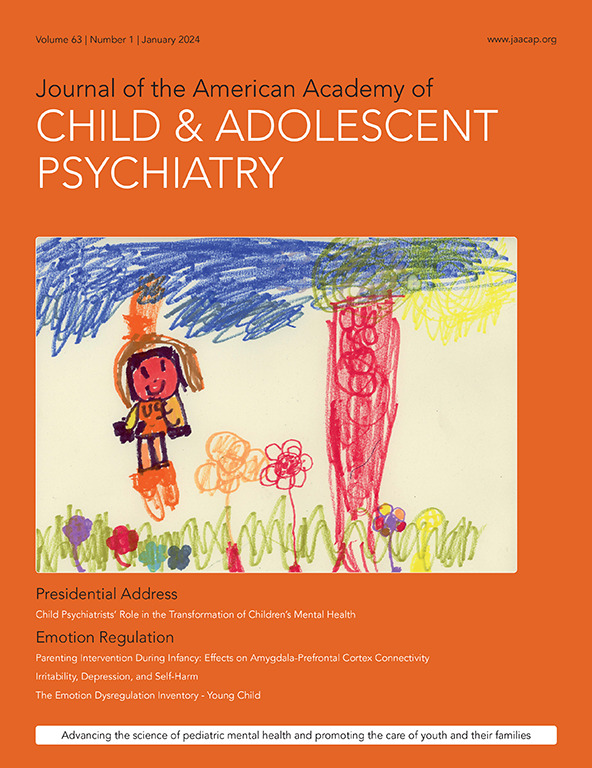系统性综述:用于测量青少年抑郁症患者抑郁症状严重程度的 "患者报告结果测量法 "的测量特性。
IF 9.2
1区 医学
Q1 PEDIATRICS
Journal of the American Academy of Child and Adolescent Psychiatry
Pub Date : 2025-02-01
DOI:10.1016/j.jaac.2024.06.011
引用次数: 0
摘要
目的系统评估用于测量青少年抑郁症患者抑郁症状严重程度的12种患者报告结果测量法(PROMs)的测量特性。鉴于抑郁症状严重程度是衡量青少年抑郁症患者临床试验和/或护理的重要结果,因此选择抑郁症状严重程度作为重点结果:方法:检索了 MEDLINE、PsycInfo、Scopus、CINAHL 和 Web of Science,检索时间从开始检索的年份起至 2023 年 12 月 7 日。研究评估(即偏倚风险)、测量属性评估和证据综合均遵循基于共识的健康测量工具选择标准(COSMIN)指南。所纳入的研究至少评估了 COSMIN 分类法中详细列出的九种测量特性中的一种,研究对象为已报告的 12-24 岁青少年样本或亚组,其中至少有 40% 符合任何抑郁障碍的标准:在已确认的 15,560 条记录中,有 31 项针对 7 个 PROM 的研究被纳入 COSMIN 评估。尽管有几项 PROMs 有可能准确测量患有抑郁症的青少年的抑郁症状严重程度,但在没有进一步评估工作的情况下,目前还不能推荐使用任何 PROMs。总体而言,缺乏高质量的证据,这主要是由于研究结果较少或不一致、样本量较小以及其他方法学方面的问题:本研究对用于测量青少年抑郁症状严重程度的 12 个 PROM 的测量属性进行了系统性回顾,结果发现,在开展进一步评估工作之前,没有一个 PROM 可以推荐使用。临床医生和研究人员在使用这些 PROM 时应谨慎行事。本文章由计算机程序翻译,如有差异,请以英文原文为准。
Systematic Review: Measurement Properties of Patient-Reported Outcome Measures Used to Measure Depression Symptom Severity in Adolescents With Depression
Objective
To systematically evaluate the measurement properties of 12 patient-reported outcome measures (PROMs) used to measure depression symptom severity in adolescents with depression. Depression symptom severity was chosen as the outcome of focus given its importance as an outcome to measure in adolescents with depression across clinical trials and/or care.
Method
MEDLINE, PsycInfo, Embase, Scopus, CINAHL, and Cochrane were searched from year of inception up to December 7, 2023. Study appraisal (ie, risk of bias), evaluation of measurement properties, and evidence synthesis followed the COnsensus-based Standards for the selection of health Measurement INstruments (COSMIN) guidelines. Included studies evaluated at least 1 of 9 measurement properties as detailed in the COSMIN taxonomy within a reported sample or subgroup of youth ages 12 to 24 years, with at least 40% meeting criteria for any depressive disorder.
Results
Of the 15,560 records identified, 31 studies for 7 PROMs were included in the COSMIN appraisal. Although several PROMs have the potential to accurately measure depression symptom severity in adolescents with depression, at this time none of the PROMs can be recommended for use without further evaluative work. High-quality evidence was generally lacking, largely due to few or inconsistent findings, small sample sizes, and other methodological concerns.
Conclusion
This systematic review of the measurement properties of 12 PROMs used to measure depression symptom severity in adolescents with depression found that none of the PROMs can be recommended for use until further evaluative work is conducted. Clinicians and researchers should proceed with caution when using these PROMs.
Plain language summary
This systematic review evaluated 12 patient report outcome measures (PROMs) commonly used to measure depression symptom severity in adolescents with depression. Only 7 of these PROMs had studies to evaluate; none of them had the necessary measurement properties to indicate that they could be recommended for use or that results could be trusted. The authors suggest that more evaluative work is required to ensure the validity of the measurement properties of the tools utilized to measure depression symptom severity in adolescents with depression. This work should include engagement of youth and caregivers in evaluation of the content validity (eg, the relevance, comprehensibility, and comprehensiveness) of these PROMs.
Diversity and Inclusion Statement
One or more of the authors of this paper self-identifies as a member of one or more historically underrepresented racial and/or ethnic groups in science. One or more of the authors of this paper self-identifies as a member of one or more historically underrepresented sexual and/or gender groups in science. We actively worked to promote sex and gender balance in our author group. We actively worked to promote inclusion of historically underrepresented racial and/or ethnic groups in science in our author group. The author list of this paper includes contributors from the location and/or community where the research was conducted who participated in the data collection, design, analysis, and/or interpretation of the work.
求助全文
通过发布文献求助,成功后即可免费获取论文全文。
去求助
来源期刊
CiteScore
21.00
自引率
1.50%
发文量
1383
审稿时长
53 days
期刊介绍:
The Journal of the American Academy of Child & Adolescent Psychiatry (JAACAP) is dedicated to advancing the field of child and adolescent psychiatry through the publication of original research and papers of theoretical, scientific, and clinical significance. Our primary focus is on the mental health of children, adolescents, and families.
We welcome unpublished manuscripts that explore various perspectives, ranging from genetic, epidemiological, neurobiological, and psychopathological research, to cognitive, behavioral, psychodynamic, and other psychotherapeutic investigations. We also encourage submissions that delve into parent-child, interpersonal, and family research, as well as clinical and empirical studies conducted in inpatient, outpatient, consultation-liaison, and school-based settings.
In addition to publishing research, we aim to promote the well-being of children and families by featuring scholarly papers on topics such as health policy, legislation, advocacy, culture, society, and service provision in relation to mental health.
At JAACAP, we strive to foster collaboration and dialogue among researchers, clinicians, and policy-makers in order to enhance our understanding and approach to child and adolescent mental health.

 求助内容:
求助内容: 应助结果提醒方式:
应助结果提醒方式:


